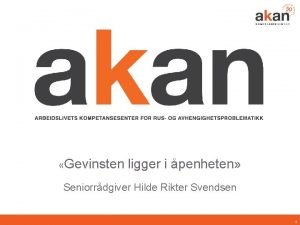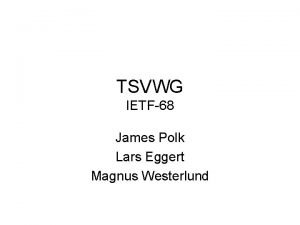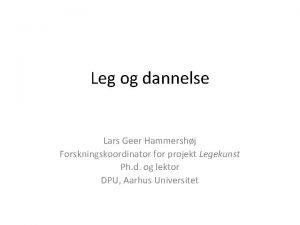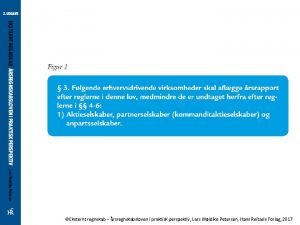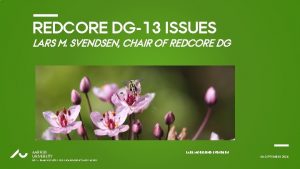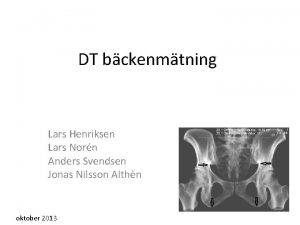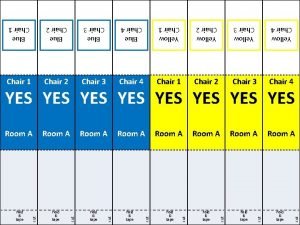REDCORE DG13 ISSUES LARS M SVENDSEN CHAIR OF






- Slides: 6

REDCORE DG-13 ISSUES LARS M. SVENDSEN, CHAIR OF REDCORE DG AU AARHUS UNIVERSITY DCE – DANISH CENTRE FOR ENVIRONMENT AND ENERGY LARS MOESLUND SVENDSEN 04 SEPTEMBER 2016

CART ASSESSMENT METHODOLOGIES Pressure discussed and agreed on the outline of the scientific report: • Bibliography • Executive summary • Assessment follow-up concept • Main Results: • Overall fulfilment of CART • Latest available inputs compared with inputs ceilings • Changes in inputs since the reference period (1997 -2013) • Trends and changes in inputs during 1995 -2014 • Comparison with the main results of first CART follow-up assessment AU AARHUS UNIVERSITY DCE – DANISH CENTRE FOR ENVIRONMENT AND ENERGY LARS MOESLUND SVENDSEN 04 SEPTEMBER 2016

CART ASSESSMENT METHODOLOGIES In depth information: • Methodology: • Calculation of net inputs • Calculation of nutrient inputs Statistical trend analysis including break points and calculation of changes in inputs • Calculation of uncertainties of the assessment • Detailed evaluation of the fulfilment of nutrient inputs ceilings country per basin • Accounting for extra reduction • Detailed data on changes in inputs since the reference period (1997 -2003) • Detailed data on changes in inputs during 1995 -2014 • References. AU AARHUS UNIVERSITY DCE – DANISH CENTRE FOR ENVIRONMENT AND ENERGY LARS MOESLUND SVENDSEN 04 SEPTEMBER 2016

CART ASSESSMENT METHODOLOGIES u u The policy message should be discussed in the MAI/CART assessment workshop (agenda item 8 today) but should answer three main issues: › Are the reduction targets acheived? › What is the distance from the target? › What is the trend in inputs? Overall the assessment methodologies will follow the ones used for the first CART followup assessment, but with some adjustment and testing of certain steps: › Establishing the assessment dataset – no major changes, although some improvement might be required regarding transboundary inputs › Flow normalization: if statistical test indicates trends in flow to some sub-basin we need to adjust the methodology. Normalization of N-deposition to be discussed with EMEP › Change data and normalization changes reference inputs – adjust CARTS then? ? ? AU AARHUS UNIVERSITY DCE – DANISH CENTRE FOR ENVIRONMENT AND ENERGY LARS MOESLUND SVENDSEN 04 SEPTEMBER 2016

CART ASSESSMENT METHODOLOGIES u Trend analysis: › u Test for linearity and as a new issue for break point i. e. if statistical necessary divide the time series, and only look on input data after the latest break point › Maybe also necessary to introduce non-linear trend test › Consider how to take into account uncertainties comparing trend from different CP’s Estimation of changes in inputs (since 1995 and/or since 1997 -2003? ): › If significant linear trend present methodology fine › Non-linear trend – introduce new methodology › Comparing changes between average of a period – use the present methodology › Consider how to take into account uncertainties comparing changes in inputs from different CP’s AU AARHUS UNIVERSITY DCE – DANISH CENTRE FOR ENVIRONMENT AND ENERGY LARS MOESLUND SVENDSEN 04 SEPTEMBER 2016

CART ASSESSMENT METHODOLOGIES u u Evaluate fulfilment of CART (and MAI): › › Statistical estimate of latest year inputs using all information in the time series › › Testing y using both methods including 3 and 5 year average X year average – not using all available information and making it more difficult to fulfil CART (and MAI) Compared CART fulfilment status in 2012 and 2014 Uncertainty added to inputs (precautionary principle) Take into account how extra reduction in one basin can help fulfilling CART in a neighboring basin More focus on estimating uncertainties – not only based on variation in annual input data, but estimating uncertainty on CP’s input dataset AU AARHUS UNIVERSITY DCE – DANISH CENTRE FOR ENVIRONMENT AND ENERGY LARS MOESLUND SVENDSEN 04 SEPTEMBER 2016
